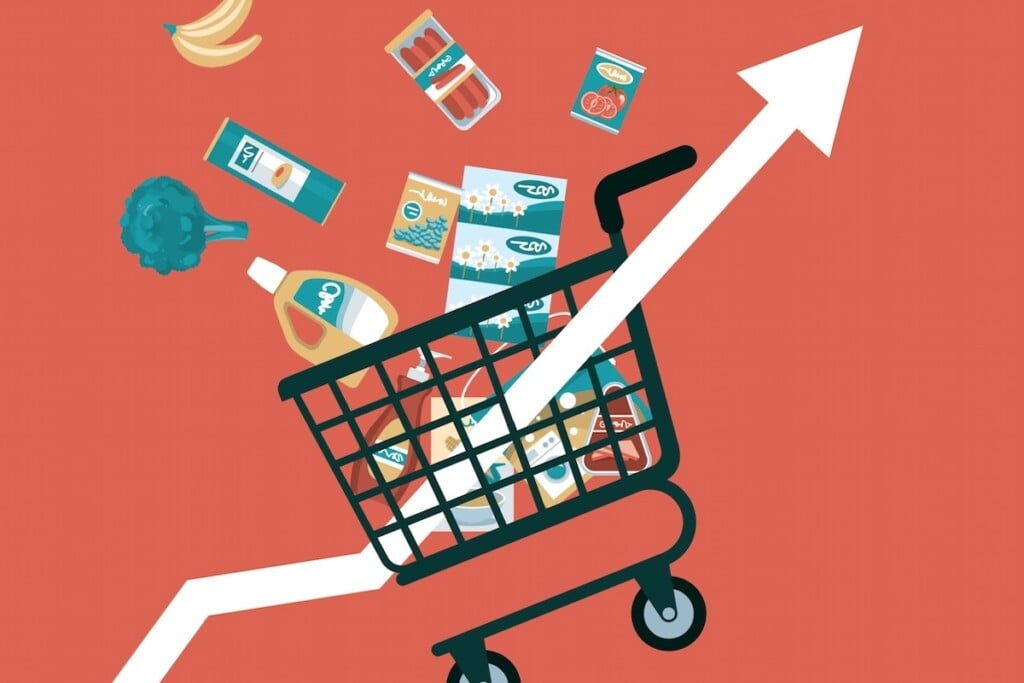Food Prices Stay High
It’s true what they say about the rate of inflation—it’s down dramatically. But grocery-store sticker shock still hurts.

On a Saturday afternoon in November 2024, the Lyndhurst Stop & Shop looks much as it did in the fall of 2019, before the word “COVID” entered the lexicon. Only a couple of shoppers are wearing surgical masks. The aisles are fully stocked. Staples—from eggs to pasta to that once-scarcest of commodities, toilet paper—are abundant. But check the price of those staples—and pretty much anything else in the store—and visions of 2019 quickly vaporize. A dozen eggs? Five years ago they cost, on average, $1.20; today a dozen store-brand, cage-free medium brown eggs are going for $3.49— an almost 200-percent increase. Pasta? In 2019, the average cost of a 16-ounce box of pasta was $0.72; today, a box of store brand spaghetti is $1.25—an almost 74-percent rise.
The story is the same at virtually every supermarket in Bergen County: In a world beset by inflation, food prices stand out, having risen by 25 percent over the past five years, as opposed to an overall inflation of 20 percent. Those escalating prices have changed the way many of us shop, the things we buy, and even our relationship with food.
Kate Silva is at Stop & Shop’s self-checkout, paying for three bags of Utz potato chips—“on special for $1.97 each,” she says. She came to the store specifically for those chips; these days she does most of her shopping at Costco, where she splits supersized items, from ground beef to peanut butter, with a friend. “We do save money that way,” she explains, “but we don’t always want the same things, so I do spot-shopping like this at the supermarket.” Even though she’s heard that the rate of inflation is slowing, she doesn’t expect food prices to come down any time soon.
FOOD-PRICE INFLATION 101
According to Zachary Thomas, professor of social science at Bergen Community College, she’s right. “Inflation is a continued rise in pricing,” he says, “so when we see that inflation has come down, it doesn’t mean that prices are going down.” In 2020, the annual rate of inflation—the percentage at which prices in general were rising over the course of a year—was 1.4 percent; in 2021 it shot up to 7 percent, thanks largely to supply-chain issues sparked by the COVID-19 pandemic. From 2022 to 2024, the rate of inflation has dropped from 6.5 percent to 3.4 percent to its current rate (as of this writing) of 2.5 percent. Again, that doesn’t mean that prices are dropping commensurately, just that they’re rising much more slowly.
Food prices have suffered from a slightly higher rate of inflation than prices in general largely because of what Thomas calls “overreach.” It’s a normal phenomenon in a market economy that often accompanies inflation, when businesses try to raise prices slightly above the rate of inflation. Generally, the market itself takes care of these extra-inflationary price rises. “When businesses set prices too high, people elect not to buy at those prices,” says Thomas. If shoppers, for instance, aren’t happy with the price of oatmeal at a particular store, they’ll buy it elsewhere, switch to a cheaper brand or just go without it. In fact, that seems to be happening now, as shoppers embrace cheaper store brands over name brands.
So, if prices aren’t likely to come down, how will consumers ever catch up? “It’s not about food prices dropping,” says Thomas, “but about wages going up.” And in fact, that’s what’s been happening over the past couple of years, as income has outpaced inflation.
For those whose incomes haven’t yet caught up, food shopping hasn’t lost its sting, which helps to explain why consumers are changing the way they buy food. Some, like Silva, are shopping with a friend and buying in bulk. Others are changing where they shop. Lisa Lovermi, a Fair Lawn resident, has largely left her longtime favorite supermarket in favor of grocers known for lower prices, such as Aldi and Lidl. And she divides her shopping among different stores—another growing trend among shoppers looking to save money, if not time. “I’m not working at the moment,” says Lovermi, “so I have plenty of free time. I’ll go to one store for certain things, another store for other things. I no longer shop in just one store.”
Wherever they’re shopping, consumers are increasingly turning to so-called private-label brands, like ShopRite’s Bowl & Basket and Stop & Shop’s Nature’s Promise. In fact, over the past year, U.S. private-label sales grew by 6 percent. Even well-to-do consumers are changing their shopping habits. Gail Schoenberg of Woodcliff Lake, for instance, shops for food, more often than not, at farmers’ markets. “Not that they’re inexpensive,” she says, “but I feel better buying from somebody directly that I’m helping than I do just buying some brand-name and/or store-brand product. The sourdough at the grocery store isn’t going to be as good as the fresh-baked. The fresh-baked is going for $10 a loaf, but it’s a beautiful loaf of bread.”
BESTING INFLATION
As many consumers have already discovered, there are ways to combat food-price inflation. In addition to the changed habits described above, consumer and nutrition experts recommend the following strategies:
• Get acquainted with unit pricing. A lower price doesn’t necessarily mean you’re getting a bargain—it could simply indicate that there’s less product per bag, box or jar. Read the unit price label to determine the actual value of the food you’re buying, advises Christine Zellers, a health sciences educator at Rutgers Cooperative Extension.
• Buy fruits, vegetables and even seafood in season. “You’re likely to get a better price because there are no major transportation costs tacked on,” says Zellers.
• When buying produce, compare the prices of fresh, frozen and canned to get the best deal. “But if you’re buying canned, choose the low-sodium option,” Zellers advises.
• Compare prices—not just among brands but among stores. Apps like Flipp, Instacart, Basket Savings and Grocery AI allow you to find the best deals in your area.
• Unpack the package habit. Prepackaged food—whether it’s a heat-and-eat meal or pre-sliced veggies—costs more. “You have to think differently about food. Yes, that means you have to cook,” says Stacey Antine, a dietitian and the founder of the Ridgewood-based company HealthBarn USA. “But ultimately, thinking differently is going to be healthier.”
THOSE HARDEST HIT
There’s another group in Bergen suffering from food-price inflation, less visible and perhaps less vocal than everyday shoppers. The nonprofits that provide food to Bergen’s food-insecure are finding it harder, in the face of inflation, to fulfill that mission. The cause is twofold. “As a result of the high prices in the supermarket,” says Karen DeMarco, president of The Food Brigade, headquartered in Paramus, “there has been a substantial increase in the number of people who use the pantry.” Families who were balancing on the edge of economic hardship five years ago can no longer afford to feed themselves without assistance. “One unexpected expense, like a car repair or a medical bill, can be catastrophic for our families,” says Nancy Dreszler, director of Ridgewood’s Social Service Association (SSA) and the Ridgewood Food Pantry. “So we see more and more people coming through our doors.” She notes that in August 2019 the pantry gave out 309 bags of food; this past August it distributed 504. “The increased demand in the community,” she says, “makes it difficult to keep our shelves stocked.”
“Many of the pantries were caught unaware by the increased demand. Since the pandemic,” says Nicole Davis, executive director of Englewood’s Center for Food Action, “we thought that we would go back to prepandemic levels of people coming to see us. Instead, numbers have steadily increased.”
On top of increased demand, many pantries are experiencing decreased supply. The Food Brigade gets a portion of its food from supermarkets, which donate produce—perfectly good but less than perfect—that they would otherwise throw out. But as a result of inflation, DeMarco says, “food stores are now getting more conscientious about what they’re spending, so there’s a little less waste, which means there’s less food for us.”
Many pantries buy food—particularly produce and fresh meats—to plug the hole between donated supply and demand. Inflation has reduced their buying power, and donations—particularly monetary donations—are down, again, thanks to inflation. Because the Ridgewood SSA isn’t able to stock fresh food, it offers clients food vouchers they can use to shop in local supermarkets. Because of inflation, the nonprofit recently increased the value of the vouchers, but it hasn’t received a commensurate increase in monetary donations.
Food pantries encounter another impediment to keeping pace with inflation—a misapprehension that Davis calls “the Bergen County bubble.” “Bergen County is the 33rd richest county in the U.S.,” she says. “And sometimes it’s hard for us to convince people that food insecurity and homelessness, or being on the verge of homelessness, exist here.” The bubble can mean decreased donations at a time when the need has actually increased.
Even for Bergenites who have plenty to eat and plenty of shopping choices, grocery prices feel high in 2024. And most of them probably won’t return to their 2019 levels. Our rising incomes may have kept pace with inflation or even surpassed it, but that doesn’t change—at least not quickly—our perception of how prices “feel” or what food items are “worth.” And that is stressful. Still, if grocery-store sticker shock prompts us to become more prudent shoppers, it will be a case of a troubling trend with one ultimately beneficial result.
HELP YOUR NEIGHBORS BY GIVING TO FOOD PANTRIES
Food-price inflation is an inconvenience for most of us—and maybe a budget squeezer. But for Bergen’s food-insecure population the phenomenon makes a dire situation worse. Food pantries try to address the need, but they’re facing increasing headwinds. Here’s some advice from experts on how you can help:
• Consider a cash gift. Even food pantries that aren’t facing empty shelves have operating costs they need to cover. “There’s a huge amount of incidental expenses involved in running a food pantry: rent, electricity, the cost of box cutters and gloves,” says Karen DeMarco, president of Paramus-based The Food Brigade. Cash donations also cover the costs of food vouchers, according to Nancy Dreszler, director of Ridgewood’s Social Service Association (SSA) and the Ridgewood Food Pantry.
• Buy one, give one. “When you see a ‘buy one, get one’ item at the supermarket, consider picking up two and donating one of them,” says Dreszler.
• Become a recurring donor. Planning your gift on a repeating basis “allows us to better forecast our needs over time,” says Nicole Davis, executive director of Englewood’s Center for Food Action. And it helps to ensure that, for everyone in Bergen, there’ll be food on the shelves—and on the table. These organizations can help you turn your concern into tangible help for neighbors for whom rising food prices are more than a hassle:
• Center for Food Action, Englewood – cfanj.org
• The Food Brigade, Paramus – foodbrigade.org
• Ridgewood Food Pantry – ssaridgewood.org For more on Bergen’s food pantries: foodpantries.org

